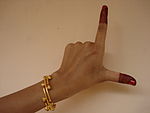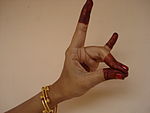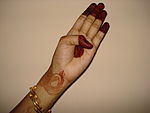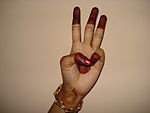RLV ANAND is one of south India’s leading choreographers and classical dancer, in constant demand as a soloist and with his own classical dance school "Yadhukulam Natygriham". Anand's association with classical dance began early at a tender stage. Anand started his training under Smt.Kalashetra Vilasini, which continued for 10 years. Under her guidance, Anand got talented and achieved a level and he choreographed his first dance at the age of 18. He hails from a Kalari family. RLV Anand has taken his diploma, post diploma, BA, MA in Bharathanatyam from RLV College, Tripunithara. Anand has contributed his own concepts to the classical dance style through his experimentation and innovations in Bharatanatyam , Mohiniyattam and Kuchipidi. He produced and choreographed several dance dramas in his own style, which are highly appreciated. Some of them are Ramayanam, Mahisasura mardanam, Geetopadesham, many forms of Kuravanji, Panjali vastrakshebam etc...also he has taken the initiative to take some poems written by famous poets and choreograph them. Anand impresses his audience with deep understanding of Bhava and Abhinaya
Best Classical Dance choreographer in kerala
Wednesday 14 October 2015
Friday 12 December 2014
RLV ANAND THE BEST CHOREOGRAPHER IN KERALA
RLV anand The most famous classical dance choreographer in kerala. A competent performer, choreographer and teacher, he heads his own dance institution "Yadhukulam Natygriham" at Chalakudy, Guruvayoor and Calicut. Rlv Anand has taken his diploma, post diploma, BA, MA in Bharathanatyam from RLV College, Tripunithara. Anand has contributed his own concepts to the traditional dance style through his experimentation and innovations in Bharatanatyam, Mohiniyattam and Kuchipidi. He produced and choreographed several dance dramas in his own style, which are highly appreciated.
Classical Dance choreographer
A competent performer, choreographer and teacher, he heads his own dance institution "Yadhukulam Natygriham" at Chalakudy, Guruvayoor and Calicut. Rlv Anand has taken his diploma, post diploma, BA, MA in Bharathanatyam from RLV College, Tripunithara. Anand has contributed his own concepts to the traditional dance style through his experimentation and innovations in Bharatanatyam, Mohiniyattam and Kuchipidi. He produced and choreographed several dance dramas in his own style, which are highly appreciated.
Classical Dances of South India
Indian Classical Dance is one of the most comprehensive and oldest dance forms in the world. Most of the development of Indian dance is linked to the 2nd century B.C. treatise. This treatise, Bharata’s Natyashastra, is the most important source for establishing the characteristics of Indian dance and drama.The Sangeet Natak Akademi, the National Academy for Music, Dance and Drama of India, confers classical status on eight dance forms of India --- Bharatanatyam, Odissi, Kuchipudi, Manipuri, Mohiniyattam, Sattriya, Kathakali, and Kathak. Out of these eight, four originated in South India. They are Bharatanatyam, Kuchipudi, Mohiniyattam, and Kathakali.
Bharatanatyam
Bharata Natyam is one of the eight Indian classical dance forms of India. This dance form originated in the temples and courts of southern India. Later it was documented as a performing art in the 19th century by four brothers known as the Tanjore Quartet (musicians). Their musical compositions are use for Bharata Natyam dance repertoire even today.Bharatanatyam can be performed solo or in a group. The pure dance is called nritta and the expressive is nritya. The solo dancer uses various methods of story-telling to interpret the verses and stories she performs. The person who conducts the recital is called the natatuvanar,, who is generally the guru of the dancer.
To learn mohiniyattam-kuchipudi-classical-bharatanatyam dances contact :rlvanand001@gmail.com
for more visit http://rlvanand.com/
Wednesday 12 November 2014
Famous classical choreographer in kerala
Rlv Anand is famed as one of the leading bharatanatyam, mohiniyattam, kuchipudi dancers in Kerala. Anand has contributed his own concepts to the traditional dance style through his experimentation and innovations in Bharatanatyam, Mohiniyattam and Kuchipidi. He produced and choreographed several dance dramas in his own style, which are highly appreciated. Some of them are Ramayanam, Mahisasura mardanam, Geetopadesham, many forms of Kuravanji, Panjali vastrakshebam etc...also he has taken the initiative to take some poems written by famous poets and choreograph them.
Anand impresses his audience with deep understanding of Bhava and Abhinaya. A competent performer, choreographer and teacher. Anand has contributed his own concepts to the traditional dance style through his experimentation and innovations in Bharatanatyam, Mohiniyattam and Kuchipidi. He produced and choreographed several dance dramas in his own style, which are highly appreciated.Some of them are Ramayanam, Mahisasura mardanam, Geetopadesham, many forms of Kuravanji, Panjali vastrakshebam etc.
Sunday 28 September 2014
Mohiniyattam Mudras....
Asamyukta hastas (single hand gestures)
Samayukta hastas (double hand gestures)
| Name in Sanskrit | Translation(s) in English | Other Meanings | Illustration |
|---|---|---|---|
| Anjali | Offering |  | |
| Kapotam | |||
| Karkatam | Crab | ||
| Swastikam | Auspicious sign | 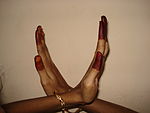 | |
| Dola-Hastam | |||
| Pushpaputam | |||
| Utsangam | |||
| Shivalingam | Phallus of Lord Shiva | ||
| Kataka-vardhanam | |||
| Kartari-swastikam | |||
| Shakatam | |||
| Shankha | Conch-shell | ||
| Chakram | Rotating disc | 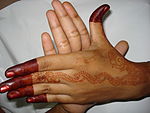 | |
| Pasha | Ropes | ||
| Kilaka | |||
| Samputa | |||
| Matsya | Fish | ||
| Kurma | Tortoise | ||
| Varaha | Boar | ||
| Garuda | Half-eagle, half-human mount of Lord Vishnu | ||
| Nagavandham | |||
| Katava | |||
| Bherunda |
Tuesday 26 August 2014
Histroy of Indian Classical Dance
In its truest sense, Indian classical dance is an expression of life, involving the body as well as the emotions. Indian Dance is based on texts from Sanskrit, an ancient Indian language – also thought to be the mother of not only Indian languages but also modern European languages. Indian classical dance is one of the oldest dance traditions associated with any of the world’s major religions. It has evolved with the concepts of self and world.
The various dance forms have also developed a particular form of make-up for the performance, which is a skill by itself. Several dance schools today, incorporate costume designing & make-up as special section of the curriculum. The costumes for all forms are elaborate & rich, but each form & style have their own traditional patterns set down. Jewels for the dancers are also specially created to suit their purpose. Flowers adorn their hair & in the case of portrayal of Gods, their necks as garlands. The hall is also richly decorated with flowers. Application of mehendi in various styles is also an essential part of the make-up in most forms.
Dance forms were nurtured with a purpose in the sacred premises of temples.
Temple dancing was imbued with the idea of taking art to the people, and conveying a message to the masses. The temple rituals necessitated the physical presence of mortal women (instead of the ornate, carved figures of heavenly damsels, apsaras) to propitiate the gods. The allegorical view of dance, used for the purpose of the pleasing the devas, was gradually transformed into a regular, service (with deep religious connotations) in the temples of the medieval times.Indian classical dance has a rich legacy and heritage. This legacy and heritage is also present today because of the efforts of prominent dancers of India. These classical dancers have attained mastery over the art of dance with their constant hard work, determination and passion. Dancers of India have presented a poetic expression to different attributes of life.
Friday 18 July 2014
Famous online Bharatanatyam dancers
Rlv Anand is famed as one of the leading bharatanatyam,mohiniyattam,kuchipudi dancers in Kerala. Anand has contributed his own concepts to the traditional dance style through his experimentation and innovations in Bharatanatyam, Mohiniyattam and Kuchipidi. He produced and choreographed several dance dramas in his own style, which are highly appreciated. Some of them are Ramayanam, Mahisasura mardanam, Geetopadesham, many forms of Kuravanji, Panjali vastrakshebam etc...also he has taken the initiative to take some poems written by famous poets and choreograph them. Anand impresses his audience with deep understanding of Bhava and Abhinaya.
Wednesday 16 July 2014
Indian Classical Dances
Kuchipudi
Kuchipudi is a Classical Indian Dance from Andrapradesh India. It is also popular all over South India.Kuchupidi is the name of a village in the Divi Taluka of Krishna District that borders the Bay of Bengal and also the of the resident Brahmins practicing this traditional
dance form, it acquired the present name. Kuchipudi derives its name from the village of Kuchelapuram, in Andhra
Pradesh, India. As a classical form of dance, drama and music Kuchipudi enjoys
a unique place among the Indian classical idioms. Kuchipudi grew largely as a
product of the Bhakti movement beginning in the seventh century A.D. However,
it was in the 14th century that the ascetic Siddhendra Yogi appeared on the
scene and gave Kuchipudi a new definition and direction.
Kuchipudi
is purely classical in nature and employs Lasya, Thandava and Abinaya with the
purpose of interpretation of Slokas. The classical Indian art also includes
Samyutha, Asamyutha Hasthas, Karana, Chari, Angahara, Mandala, Nrutha Hasthas
etc. It is unique dance form in the sense that it makes intricate use of four
Abhinayas namely Angika, Vachika, Aaharya and Satvica respectively.
Modern
Kuchipudi acquired its present form in the 20th century. A number of people were responsible for
moving it from the villages to the performance stage. One of the most notable was guru
Lakshminarayan Shastry. After him, a
number of other luminaries would mould it into its present shape. Some notable names are Vempati Chinna Satyam,
C.R. Acharyalu, and Dr. Nataraja Ramakrishna.
Subscribe to:
Posts (Atom)


.jpg)

.jpg)


.jpg)





